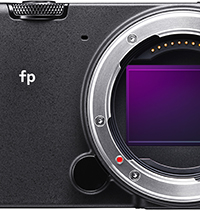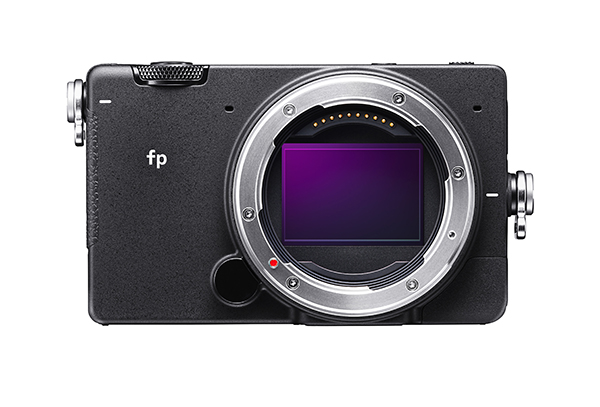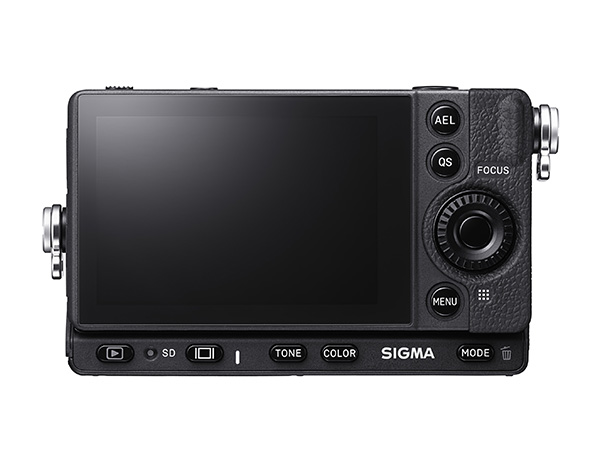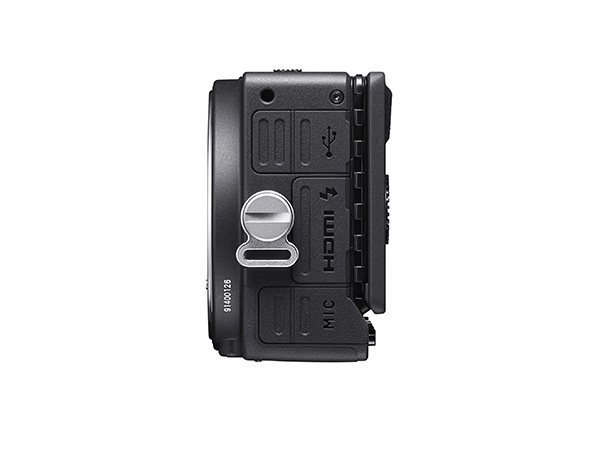| Back To Articles |
A deeper-dive on the Sigma fp: what to expect, and where does it fit?
posted Thursday, July 11, 2019 at 12:42 PM EDT

I'm pretty sure that if you asked industry experts what they thought the L-mount Alliance meant to Sigma when it was first announced, they would have stopped at "lens development." That made sense: it's what Sigma touted on-stage when Panasonic, Leica and Sigma all announced this partnership.
Clearly, this L-Mount Alliance is a lot more deeply woven together among the three companies than previously thought.
This morning Sigma announced quite the surprise, given that somehow it managed to go completely un-leaked despite the three lenses Sigma announced making their way online as early as last week. The fp, or fortissimo/pianissimo (Italian for very big and very small), is the smallest full-frame interchangeable lens camera ever, and it comes to us from Sigma, an unlikely source if you asked a majority of the camera industry.

Sigma has made cameras in the past, but they have used the Foveon sensor as their basis, and focused on stills. This camera uses a traditional Bayer sensor, and actually seems to lean more towards use by videographers than traditional still photographers.
The Sigma fp uses a full-frame, 24.6-megapixel, backside-illuminated Bayer sensor, which is in the same vein as what we've seen inside both the Sony A7 III and the Panasonic S1, for example. Though not exactly the same resolution, it's likely a Sony sensor made for Sigma based on the specifications from the IMX410C1K CMOS sensor offered by Sony's sensor division. That sensor is capable of capturing 4K UHD (there are no cinema 4K options offered on the fp) in both CinemaDNG RAW and MOV (ALL-I) to the single SD card slot or external recorder. It will capture CinemaDNG RAW in 8bit, 10bit or 12bit at 23.98p. It can also capture 1080p Full HD footage up to 119.88p in 4:2:2 8bit.
Sigma also made reference to different sensor aspect ratios being used in filmmaking, leading us to believe you can shoot in different aspects on the Sigma fp (like full-frame, Super35, etc). More aspect ratios will apparently be offered via a firmware update, as part of a "Director's Viewfinder" mode although it's not clear whether it will record in those modes, or just offer real-time viewing, replacing the ungainly optical setups that directors use to visualize field of view on different formats with their cine lenses.

You're probably used to using external recorders with HDMI, but as many folks have asked me in recent years: why? HDMI isn't really the best type of connection for transmitting super high data rates, and Sigma seems to agree. The fp will transfer its CinemaDNG RAW video feeds through USB-C (USB 3.1 GEN1), and Sigma also says it is compatible with other "cinema camera-like user interfaces" and therefore can be "taken straight to video production settings."
That's not to say that HDMI is not supported on the fp, as there is still the HDMI-out interface on the side of the camera. Next to it are both the USB-C connection and the microphone jack.

I want to loop back and talk more about the video uses for this camera in a moment, but I also don't want to entirely neglect talking about the still capabilities of this camera because unlike most video-centric cameras, this one actually seems to have a lot of still image capability as well.
The Sigma fp makes full use of that 24.6-megapixel sensor with a variety of aspect ratio options and shooting speeds. It captures RAW files in 12-bit or 14-bit lossless compressed, and shoots at up to 18 frames per second. It is using a contrast-detect autofocus system, but Sigma does list a technology called "moving object prediction function" which may translate to better tracking. Hard to say at this point, we will have to wait until the camera is released to get more information on how well it performs. It is worth noting that the Sigma fp will launch with eye-detection AF, so perhaps (and this is purely speculation) they are using their partnership with Panasonic to create a successful contrast-only system.
Now is also as good a time as any to mention that the fp will not use any type of mechanical shutter, instead opting to be fully electronic. With large sensors and electronic shutters generally comes some level of rolling shutter. It is possible to make a fully electronic system that has almost no rolling shutter, as we see on the Sony A9, but it's not easy. Sigma states that this will have very low rolling shutter, but we'll have to wait and see exactly what that means when the camera is released.
The ISO on the Sigma fp is also somewhat unique, with a base ISO range of 100-25,600, but expandable to 6 (yes, you read that right, single-digit 6) and a high ISO of 102,400.
Sigma also has added some custom processed-color modes that work in both stills and video, with Teal and Orange cinema looks specifically called out as ways to mimic Hollywood styles.
Broad Context
Ok, so where does this camera fit in? Sigma's stated goals with this camera were to make something very small and entirely different than what is out there. The market obviously has been slowing down and it is, at present, extremely crowded especially in the higher end, full-frame market. But they also see that there are people who are still making great photos and videos, so there is still an opportunity if they do something niche, really well.
And that's where the Sigma fp comes in. It's a camera that looks like it can be whatever you need it to be, for the most part. There are a ton of accessories that change the way the camera looks and feels, but the base camera itself is very small and has some pretty unique designs to it. For example, it doesn't have a fan as you find on higher-end cinema cameras (which you need because those sensors produce a lot of heat), but instead a heat sink that sits between the sensor and the rear LCD.
As far as size and modularity go, the Sigma fp looks more like a Blackmagic Pocket Cinema Camera competitor than a Panasonic GH5 or S1 or even the S1H competitor. The plus side for the Sigma fp in that fight against Blackmagic is the size of the sensor and the fact it is going to take better still images than the Blackmagic will.
Overall, the Sigma takes some really good risks while also not quite being a camera that can do everything. So while it does shoot in CinemaDNG, which is awesome, it won't be able to shoot any higher frame rate video in 4K in any format: its fastest frame rate in 4K is either 24p or 30p (as of publishing time, there's a little confusion on that, between the launch presentation (claiming a max of 24p) and published specs (claiming 29.97p). It also doesn't offer a Cinema 4K aspect ratio, nor does it have a headphone jack. In order to monitor sound, you would have to use an external recorder (which, let's be honest, is probably a near-must for this camera anyway, especially if you want to get the most out of the sensor).
Additionally, though Sigma has stated it will be added as a firmware update, if you record CinemaDNG internally, the fp cannot play that video back on the camera. That's a bit of a downer, but luckily they will update the camera to fix this eventually.
Another update via firmware we've been told about is multiple crop factors, such as Super 35. Those will also be coming at a later date, which is great.
Looking at the list of what the Sigma fp can and cannot do, I'm a bit torn on who this camera is for, exactly. Nikon has announced they will support RAW video at some point on the Z cameras, and that would mean that Nikon, Blackmagic and now Sigma are the only ones who plan to do it.
But unlike Nikon, the Sigma fp doesn't have any log profiles or capture traditional video in log, which means to actually get great dynamic range and take full advantage of the sensor, you have to shoot in RAW. Shooting in RAW is kind of a pain, as the amount of storage space you need for even short clips becomes monumental. Additionally, your computer will become very taxed in editing that much data. For a camera designed to be, in what we understood in their presentation, "more affordable," it puts a lot of stress on the post-production capabilities of those who shoot with it. It's a bit of a disconnect between the kinds of users who would buy this camera (those looking for a good video camera at a lower price), and the way the camera was designed (high-end specifications requiring a lot of storage capacity and high-end computers).
A side note here: The very beginning of the presentation mentioned affordability as a problem with current cine cameras, but that may be relative. In their concept video and a few rigs they had in the touch & try area (with actually very little touching or trying allowed), the emphasis was on building it into rigs, using on a drone, cine cages, etc. A constant theme was using it to build off of, so from the presentation, it was clear that the cine part of its capabilities was aimed squarely at pros who'd build it into something, versus a pocket camera for the masses. A lot will obviously depend on the price point and there was no mention or even a hint of what that might be. Oh – and it should be noted that pro video usage would also mitigate any limitations in terms of the AF reliability on this camera. The constant emphasis from Sigma was on the use of cine lenses, which are all MF anyway.
All in all, there are definite use cases for this camera, and the size of the build cannot be overlooked. It's very small, and in that tiny package, the Sigma fp can certainly do a lot. Though we don't have an exact release date yet, just that it will be coming in the fall, and no price point either, we'll have to wait and see exactly where Sigma wants to fit into the very crowded full-frame ILC market. Their choice to use the L-Mount makes a lot of sense, and it likely means they intend to work hand-in-hand with Panasonic's offerings. If their camera can slide into a Panasonic shooter's workflow easily and offer features, like RAW video, that the Panasonic cameras cannot, then it's possible that the L-Mount Alliance will create a full ecosystem of products that can be built around. At the very least, this camera's announcement really makes us see the "L-Mount Alliance" tagline in a new light. There is a lot more at work here than just three companies making three different parts of a camera system. It feels a lot more in-depth than that now.